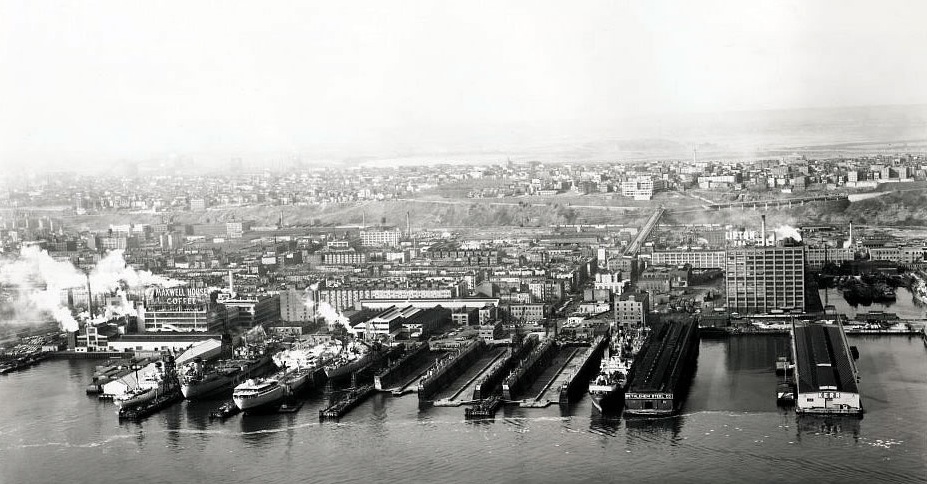 Old Hoboken Waterfront, featuring the Maxwell House coffee plant (far left) and the Lipton tea plant (far right).
Old Hoboken Waterfront, featuring the Maxwell House coffee plant (far left) and the Lipton tea plant (far right).
1.
Both the Lipton Tea and the Maxwell House plants used to be situated at the north end of Hoboken’s Frank Sinatra Drive, a winding riverside road on the New Jersey side of the Hudson River. Built to capitalize on the town’s proximity to Manhattan, and also the accommodating docks famously depicted in On the Waterfront, the two plants employed generations of workers from Hoboken and its surrounding area. In the mornings, the entire town smelled like tealeaves and roasted coffee.
During my lifetime, both buildings underwent a routine familiar to residents of “up-and-coming” neighborhoods across America: they were closed, sold, and replaced with luxury condominiums. Today Eli Manning owns a fully automated apartment in the Hudson Tea Building. A one-bedroom at Maxwell Place rents for $3,200 a month.
The rest of the town has undergone a similar transformation. Locally owned shops that used to line Washington Street — the main drag spanning the length of the Mile Square City — have in the past three decades been replaced by more and more cookie cutter storefronts from the likes of Baby Gap, Anthropologie, Panera Bread, and Chipotle. Real estate values have skyrocketed due to an influx of young, childless Wall Street workers who appreciate the PATH train’s easy access to the financial district.
Unfortunately this development has come at the expense of longtime residents, many of whom belong to the working classes. Last year Hoboken High School was ranked 298th out of 328 public schools in New Jersey. (Down from 187th the year prior.) The shrinking supply of rent-controlled apartments is always one referendum away from being diminished further. Local businesses evaporate and the town loses its identity. People who moved here for its flavor wake up one day and realize that flavor’s gone. What was at one time one of New Jersey’s most distinct towns is more and more becoming an extension of whitewashed New York, unrecognizable from any number of neighborhoods in Brooklyn. Nostalgic locals are replaced by the hipster vanguard; the hipster vanguard is replaced again. To the young newcomers who didn’t grow up here, there’s little reason to care: Hoboken is said to boast more bars per capita than any other American city.
At the end of July, however, the town will lose one of its best.
2.
The best way to understand Maxwell’s is to think of it as Hoboken’s own CBGB, but with tighter curation. A former tavern for the factory workers at the Maxwell House plant, Maxwell’s was bought by Steve Fallon and his family in 1978 and converted into a sit-down restaurant. At the time, Hoboken was undergoing its first wave of gentrification, and in order to take advantage of the burgeoning hipster scene, Maxwell’s launched the town’s first successful Sunday brunch.
By the early 1980s, however, the space began to establish itself as one of North Jersey’s premier concert venues — this despite the fact that its 200 person capacity event space was the size of a suburban garage. (Its acoustics were not dissimilar.) The place hit its stride when Fallon brought on Todd Abramson to manage bookings. He went on to host performances from major acts like Sonic Youth, Fugazi, Hüsker Dü, Dinosaur Jr., Nirvana, Neutral Milk Hotel, The Smashing Pumpkins, Red Hot Chili Peppers, and The Strokes. In 1985, Bruce Springsteen and Hoboken resident John Sayles teamed up to use Maxwell’s as the set for scenes in The Boss’s music video, “Glory Days.” My mother recalls that the crowd of Springsteen fans gathered uptown was larger than the one that had assembled at St. Ann’s Feast the year before — remarkable because the Feast featured appearances from both Ronald Reagan and Frank Sinatra.
All the while, Maxwell’s also hosted a steady stream of diverse punk, grunge, and indie rock groups in addition to the larger touring outfits. In a testament to the range of sounds you could experience, check out the “Away” video The Feelies recorded (the year I was born) on the same stage that (24 years hence) would feature a sold out performance from The Sun The Moon The Stars. Now add to the mix the knowledge that Yo La Tengo performed there more times than I can count — even playing the eight nights of Hanukkah every year. Add to that the knowledge that once a month the place would remove all the tables and host Dave Post’s Swingadelic project in the dining area. You get the idea.
Yet Maxwell’s has always been a microcosm for what was going on in the town as a whole. It’s a case study for the prevailing trends: not only was it a product of gentrification’s inexorable march, but now it’s a victim of it as well. In recent years, the local crowds have steadily ceded ground to visitors. It’s a trend depicted in Jonathan Franzen’s Freedom, which noted that Richard Katz had to drive into Hoboken in order to drop off his guitar. (The staff memorably treated him “like a General MacArthur returning from Korea in defiant disgrace.”) In recent years, more and more noise complaints forced shows to end early. It’s become uncommon to see Hoboken residents in attendance. The town has changed. The residents who made up the previous gentrification waves have been pushed out to new frontlines, or else they’ve grown up. The current milieu is composed of frat boys and young parents. In the comments section for The Star Ledger’s report on the bar’s closing, Hoboken is described with epithets like, “frat row,” “HoBroken,” and “DOUCHEVILLE.” As I type this, I hear the distinct click-clack of stiletto heels coming from the two girls who live next door. Monday night is when they go clubbing at places like Boa and Room 84 — both of which opened in the past year, and both of which pull nightly crowds bigger than Maxwell’s weekly draw.
3.
This is not the first time Maxwell’s has shut its doors. In the mid-90s the place was briefly converted into a fancy brewpub. Big metal casks lined the windows and the place played the radio. Three years later, the bar as we knew it was rescued and reopened thanks to an alliance between Dave Post and Sonic Youth drummer Steve Shelley. But this time feels different.
“The culture in Hoboken is driven by TV now,” Abramson recently told Ledger reporter Tris McCall. “A lot of the bars downtown are fighting with each other for who has the most giant TVs. That’s what Hoboken nightlife has become.” He’s not wrong. The most popular bar to have opened in town over the past year is owned by one of the families in The Real Housewives of New Jersey.
And so it goes. What started decades ago with the demolition of the Maxwell House plant will continue next month. The town’s newest residents, no doubt drawn by the allure of once-affordable rents as well as the quirky nature of my hometown — a nature established by places like Maxwell’s — will have unintentionally contributed to a rising cost of living, a rapidly emptying high school, the proliferation of chain stores, and the demise of a cultural institution. Soon I’ll move away, and when I come back years later, I’ll see a whole new town with a whole new set of problems. Meanwhile, I can’t help but feel that somewhere else in America, a small bar or restaurant owner is looking at their back seating area and thinking, “Hey, this just might work.”
Image via Hoboken411.







